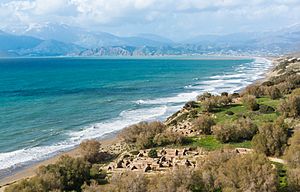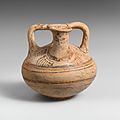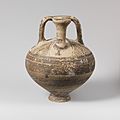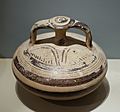Stirrup jar facts for kids
Quick facts for kids Stirrup jar |
|
|---|---|
| Linear B ka-ra-re-we, probably krairēwes from κραῖρα, "head, extremity, protrusion". | |
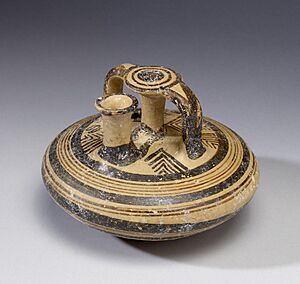
Mycenaean (above) and Minoan (below) stirrup jars
|
|
| Material | Ceramic |
| Writing | About 10 instances of the LH/LM IIIB transport type have Linear B inscriptions. |
| Created | Late Bronze Age, with an origin in the late Middle Bronze Age |
| Discovered | Eastern Mediterranean, especially Crete and mainland Greece |
| Discovered by | Schliemann. |
| Classification | pouring vessel |
| Culture | Mycenaean Greece, Minoan Crete |
A stirrup jar is a special type of pot from ancient times. It was mainly used by the Mycenaean people in Greece. These jars have a unique shape: a small, round body, a spout for pouring liquids, and a second fake spout. The handles connect over this fake spout, looking a bit like a stirrup on a saddle.
During the Late Bronze Age, these jars were super important for shipping oils, especially olive oil. You can find many of them at old sites all around the Eastern Mediterranean Sea. The name "stirrup-jar" comes from Heinrich Schliemann, a famous archaeologist. He found the first ones when he was digging at Troy.
Contents
How Stirrup Jars Developed
Even though we link stirrup jars to Mycenaean Greece, many experts think they were actually invented by the Minoans on the island of Crete. One idea is that they first appeared in the Middle Bronze Age. They were designed to make pouring expensive liquids easier and less messy.
Older pots had to be tipped almost completely upside down to pour. But with a stirrup jar, you just hold it by its stirrups and tilt it slightly. This made pouring much more controlled. Early stirrup jars were found on Crete and then spread to other islands like the Cyclades. Later, they became popular in mainland Greece. Mycenaean stirrup jars were very similar in shape, but Minoan ones had more variety.
Artistic Designs on Jars
Stirrup jars were often decorated with cool designs. The main areas for decoration were the body and the shoulder (the top part). These areas were usually outlined with colorful bands. These bands are on almost every stirrup jar, whether there are other paintings or not. Sometimes, the bands were the only decoration on the whole pot.
Artists made these designs by putting a special liquid clay, called slip, on the pot. They did this when the pot was partly dry or after it had been fired a little. After the final firing in a hot oven, the designs became a permanent part of the jar's surface.
Where Stirrup Jars Were Found
Archaeologists have found stirrup jars at many ancient sites across the Eastern Mediterranean. This includes places in mainland Greece, the Cyclades islands, Crete, Cyprus, Rhodes, Asia Minor, and even Ancient Egypt. They are a key sign of Mycenaean culture. You can find them from the early Mycenaean period all the way through the late Mycenaean period.
Ancient writings, called Linear B documents, tell us that stirrup jars were used to hold olive oil. People have guessed they might have held other things, like wine or perfume, but there's not much proof for that. Wine usually had its own types of containers, which were often larger. Perfume jars were always very small, so the larger stirrup jars wouldn't make sense for perfume.
Some stirrup jars found in Mycenae could hold about 12 to 14 liters of liquid. This suggests they were used for transporting goods, especially for export to other places. A full jar would have been quite heavy, so they probably weren't lifted just by the stirrups. They might have been moved using wooden racks or nets, similar to how large jars called amphorae were handled.
Fine and Coarse Jars
Early stirrup jars came in various sizes and shapes. Some had special features for shipping, like a disk supported by three handles instead of two stirrup handles. They also had a true spout with small bumps (called lugs) on the sides. These lugs might have been used to tie down a cloth cover over a stopper. The disk might have had holes for ties or shipping tags.
Over time, smaller, more refined jars developed. These are called "fine ware" stirrup jars. They spread across the eastern Mediterranean. "Fine ware" means the clay was very smooth, like powder. "Coarse ware" jars, on the other hand, had a rougher surface, like oatmeal, because they were made with larger grains of clay mixed with sand or other minerals.
The larger, coarser jars were often found in storage rooms. These "transport stirrup jars" were used as standard containers for shipping olive oil and other valuable liquids. Scientists have studied these jars to figure out where they came from and how they were traded.
Kommos Discoveries
Archaeologists digging at Kommos on Crete found thousands of pottery pieces, including many transport stirrup jars. Kommos was a busy port during the Late Bronze Age, trading a lot with Egypt and other places.
Scientists used special tests to find out where the clay for these pots came from. They took tiny samples from the jars and looked at them under a microscope. They also used a method called neutron activation analysis to study the chemical makeup of the clay. This helped them identify different "chemical groups" of clay, each from a unique area.
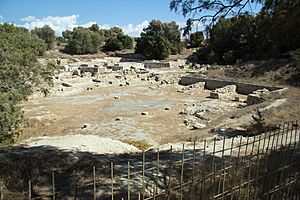
The studies showed that the stirrup jars found at Kommos were made from local Cretan clays. This means they were likely produced right there or nearby, not imported from far away. The site at Kommos even had a kiln (an oven for firing pottery) and bins for storing clay. This suggests that pottery was made there.
These findings helped experts understand that different regions made their own stirrup jars from local clays. These jars were then sold and traded, showing a lively market for goods like olive oil across the ancient world.
Stirrup Jar Sites
Crete
- Many stirrup jars with writings on them have been found at different sites on Crete, especially from Kydonia.
Rhodes
- Some of the earliest stirrup jars were found on Rhodes, dating back to around 1200 BC.
Mycenae
- At the Panagia Houses in Mycenae, twelve round, decorated stirrup jars were found. They came in two sizes: smaller, fine-ware jars and medium-sized ones.
Gallery
Science and Stirrup Jars
Stirrup jars are made from clay, which comes from weathered rock. Clay contains tiny particles and sand. When mixed with water, clay becomes a soft, moldable material. When it's baked in a very hot oven (fired), the particles stick together, making the pot hard and strong. This process is how ancient people made earthenware ceramics, often called terracotta (meaning "baked earth").
In the late 20th century, scientists at the British Museum started asking questions about Mycenaean pottery found in places like the Jordan Valley. Was this pottery imported from Greece, or was it made locally? To find out, they decided to study stirrup jars. They tested jars from different places with known origins, like a "control group."
Where Stirrup Jars Were Made
The scientists studied jars from various regions to understand where they were manufactured:
- East Peloponnesus: Jars from Mycenae and Berbati in the Argolid.
- Attica: Jars from this region.
- Aegina: One jar from this island.
- Rhodes: Jars made locally and some imported from the East Peloponnesus and Attica.
- Crete: Jars from Knossos.
- Cyprus: Local Cypriot jars and some imported from the East Peloponnesus.
- Caria: One jar from Assarlik.
- Egypt: No jars were made here, but some were imported from the East Peloponnesus.
They also tested jars from Tell es-Sa'idiyeh in Jordan. This scientific data helped answer important questions: Who used stirrup jars? When? Who made them? Where? How did they travel from one place to another?
The studies showed that stirrup jars were made in several different regions. These regions weren't necessarily political groups, but places where jars were made from local clays. They were then sold both locally and for export. This means that anyone in a region could make and ship pottery freely.
Scientists found that in earlier times (around the 14th and 13th centuries BC), stirrup jars from the East Peloponnesus were shipped to Egypt, Palestine, Rhodes, and Cyprus. Later, Cyprus and Rhodes started making their own jars. This suggests that as time went on, more places learned to make these useful pots themselves.




